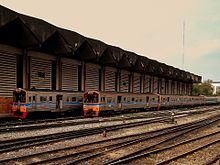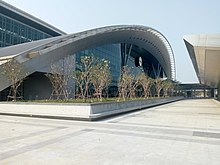Rail transport in Thailand
It covers an area of 274,192 square meters, making it the largest railway station in Southeast Asia, and is situated in a new central business district (CBD) that is currently being developed.
Its earliest recorded railway-related event dates back to 1855, when King Rama IV received a model railway as a gift from Queen Victoria.
[12][14] The Northern Line, which extended to Chiang Mai, was constructed from Ayutthaya, and the Lopburi segment was the first part of this railway route to become operational, opening for service in 1901.
Initially erected under the reign of King Rama V, the station served as a crucial railway transportation center in Thailand until Krung Thep Aphiwat Central Terminal was constructed.
The Airport Rail Link, which opened in 2010 and has transformed commuting in the capital city, is owned by the State Railway of Thailand and operated by its subsidiary, the SRT Electric Train (SRTET).
[21][22] The Bangkok–Chiang Mai route, which covers a distance of 688 kilometers, has been the focus of joint efforts by Thailand and Japan since the signing of a Memorandum of Cooperation (MOC) in 2015.
[24] This upgrade has gradually been extended to mainlines throughout the country, with Automatic Train Protection (ATP) being put in place to ensure the highest safety standards for railway transportation.
The DRT is responsible for regulating and standardizing policies, strategies, and plans for supervising rail transport businesses throughout the country, with the goal of improving safety, efficiency, and reliability.
The company is currently focusing on the areas around Krung Thep Aphiwat Central Terminal, Thonburi, and Mae Nam with plans to develop them into major mixed-use projects.
Karnchang (CK), Bangkok Expressway and Metro (BEM), Italian-Thai Development (ITD), and China Railway Construction Corporation (CRCC).
The companies were established by the BSR consortium consisting of BTS Group Holdings (BTSG) with Sino-Thai Engineering and Construction (STEC), and Ratchaburi Electricity Generation Holding (RATCH), who won the bid to construct and operate both monorail systems in early December 2016, and signed contracts with the Mass Rapid Transit Authority of Thailand in June 2017.
[65] The plan aimed to extend the mass transit lines and build new constructions to achieve a total length of 103 kilometers, including the Bangkok Elevated Road and Train System (BERTS).
When the BERTS project was canceled, the MTMP was renamed the Urban Rail Transportation Master Plan in Bangkok and Surrounding Area (URMAP).
[74] However, the Thai government faced some issues with M-MAP, including inaccurate demand forecasting and lack of integration with urban development plans.
In the long-term phase, covering 2 routes and a total of 759 kilometers, the plan is to further extend the Southern Line, first from Hua Hin to Surat Thani and then further to Padang Besar.
[citation needed] The Don Mueang-Suvarnabhumi-U-Tapao route, connecting three major airports over a distance of 220 kilometers, signed a joint venture agreement on 24 October 2019.
[93] The agreement was signed with Eastern High-Speed Rail Linking Three Airports, a consortium led by The Charoen Pokphand (CP) and consisting of Italian-Thai Development, China Railway Construction Corporation, CH.
[citation needed] The Bangkok-Chiang Mai route spans 688 kilometers, is a joint effort between Thailand and Japan since the signing of a Memorandum of Cooperation (MOC) in 2015.
The urgent phase includes the first section connecting Bangkok to Phitsanulok, for which a feasibility study has been conducted by the Japan International Cooperation Agency (JICA) since 2017.
[112] In December 2021, the SRT received 17 air-conditioned KiHa 183 series diesel multiple unit trains from JR Hokkaido, paying only for shipping.
[113] The SRT has collaborated with King Mongkut's Institute of Technology Ladkrabang (KMITL) and Energy Absolute (EA) to develop a locally made battery-electric locomotive prototype under the "EV on Train" project.
The prototype was finalized in 2022, and the SRT plans to produce three more battery locomotives and procure another 50 from other sources this year to replace its aging fleet of diesel engines.
[114] Electric multiple units (EMUs) are the primary type of rolling stock used in Bangkok's rapid transit systems due to their environmental sustainability and efficiency.
Meanwhile, the J-TREC Sustina S24 EMUs are used exclusively on the Purple Line and feature a lightweight stainless steel design, making them more energy-efficient and reducing maintenance costs.
[118] The State Railway of Thailand awarded the Red Line Project contract to Hitachi, Mitsubishi Heavy Industries, and Sumitomo Corporation on 30 March 2016.
It also features spacious aisles and large doors, making it easy for passengers to board and disembark, and providing ample room for luggage.
[127] Thailand's first high-speed train service on the Northeastern Line, connecting Bangkok to Nong Khai, will be powered by the Fuxing Hao CR300, which is expected to arrive in 2024.
[129] Meanwhile, on the Northern Line connecting Bangkok to Chiang Mai, Japan has suggested employing Shinkansen trains, which can reach a maximum speed of 300 km/h.
It is also linked to the Blue Line[131] To further improve the station's accessibility and convenience for all passengers, including those with disabilities and the elderly, a double-track railway project is currently underway.
The new signalling mandate being adopted is the European Train Control System (ETCS), a standard that boosts capacity and increases the reliability of rail networks.



















